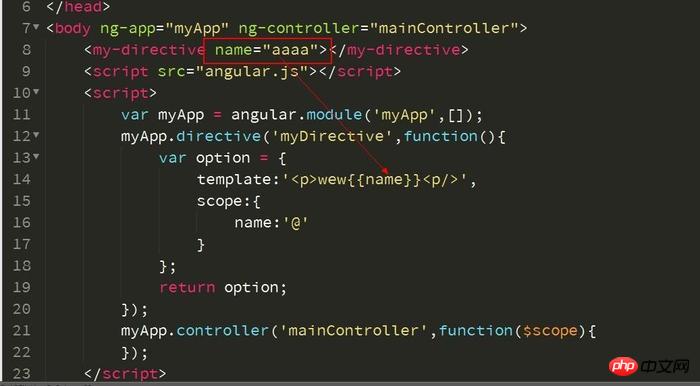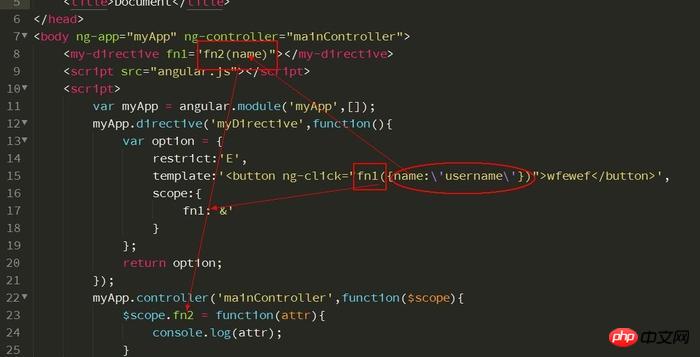angular獨立作用域的使用概念
這次帶給大家angular獨立作用域的使用概念,angular獨立作用域的使用注意事項有哪些,下面就是實戰案例,一起來看一下。
<!DOCTYPE html><html lang="en"><head>
<meta charset="UTF-8">
<title>Document</title></head><body ng-app="myApp" ng-controller="mainController">
<ceshi></ceshi>
<script src="angular.js"></script>
<script>
var myApp = angular.module('myApp',[]);
myApp.directive('ceshi',function(){ var option = {
template:'<p>{{abc}}</p>'
}; return option;
});
myApp.controller('mainController',function($scope){
$scope.abc = 'ericzheng';
}); </script></body></html>當我們自己創建某個指令時,這個指令肯定不可能只使用一次,是要重複多次使用的,有的在一個頁面內或者一個控制器內需要使用多次。
類似上面的這種場景,在任何一個輸入框內改變數據,都會導致其他的標籤內的數據一同發生改變,這顯然不是我們想要的,這個時候就需要獨立作用域了。
想轉換成獨立作用域只需要一行程式碼:
<!DOCTYPE html><html lang="en"><head>
<meta charset="UTF-8">
<title>Document</title></head><body ng-app="myApp" ng-controller="mainController">
<ceshi></ceshi>
<script src="angular.js"></script>
<script>
var myApp = angular.module('myApp',[]);
myApp.directive('ceshi',function(){ var option = {
template:'<p>{{abc}}</p>',
scope:{}
}; return option;
});
myApp.controller('mainController',function($scope){
$scope.abc = 'ericzheng';
}); </script></body></html>單向資料綁定:
##@運算子,雙引號內的內容當作字串進行綁定
<!DOCTYPE html><html lang="en"><head>
<meta charset="UTF-8">
<title>Document</title></head><body ng-app="myApp" ng-controller="mainController">
<my-directive name="aaaa"></my-directive>
<script src="angular.js"></script>
<script>
var myApp = angular.module('myApp',[]);
myApp.directive('myDirective',function(){ var option = {
template:'<p>wew{{name}}<p/>',
scope:{
name:'@'
}
}; return option;
});
myApp.controller('mainController',function($scope){
}); </script></body></html>
<!DOCTYPE html><html lang="en"><head>
<meta charset="UTF-8">
<title>Document</title></head><body ng-app="myApp" ng-controller="mainController">
<input type="text" ng-model="abc">
<my-directive name="abc"></my-directive>
<script src="angular.js"></script>
<script>
var myApp = angular.module('myApp',[]);
myApp.directive('myDirective',function(){ var option = {
template:'<p>wew{{name}}<input ng-model="name"><p/>',
scope:{
name:'='
}
}; return option;
});
myApp.controller('mainController',function($scope){
$scope.abc = 'ericzheng';
}); </script></body></html>
##&運算子綁定的內容是個方法
<!DOCTYPE html><html lang="en"><head>
<meta charset="UTF-8">
<title>Document</title></head><body ng-app="myApp" ng-controller="mainController">
<my-directive fn1="fn2(name)"></my-directive>
<script src="angular.js"></script>
<script>
var myApp = angular.module('myApp',[]);
myApp.directive('myDirective',function(){ var option = { restrict:'E', template:'<button ng-click="fn1({name:\'username\'})">wfewef</button>', scope:{ fn1:'&'
}
}; return option;
});
myApp.controller('mainController',function($scope){
$scope.fn2 = function(attr){ console.log(attr);
}
}); </script></body></html> 如何看懂:
如何看懂:
相信看了本文案例你已經掌握了方法,更多精彩請關注php中文網其它相關文章!
推薦閱讀:
angular的scopel指令使用詳解Angular Material的使用詳解#angularjs中$apply()的使用詳解以上是angular獨立作用域的使用概念的詳細內容。更多資訊請關注PHP中文網其他相關文章!

熱AI工具

Undresser.AI Undress
人工智慧驅動的應用程序,用於創建逼真的裸體照片

AI Clothes Remover
用於從照片中去除衣服的線上人工智慧工具。

Undress AI Tool
免費脫衣圖片

Clothoff.io
AI脫衣器

Video Face Swap
使用我們完全免費的人工智慧換臉工具,輕鬆在任何影片中換臉!

熱門文章

熱工具

記事本++7.3.1
好用且免費的程式碼編輯器

SublimeText3漢化版
中文版,非常好用

禪工作室 13.0.1
強大的PHP整合開發環境

Dreamweaver CS6
視覺化網頁開發工具

SublimeText3 Mac版
神級程式碼編輯軟體(SublimeText3)
 c語言中typedef struct的用法
May 09, 2024 am 10:15 AM
c語言中typedef struct的用法
May 09, 2024 am 10:15 AM
typedef struct 在 C 語言中用於建立結構體類型別名,簡化結構體使用。它透過指定結構體別名將一個新的資料類型作為現有結構體的別名。優點包括增強可讀性、程式碼重複使用和類型檢查。注意:在使用別名前必須定義結構體,別名在程式中必須唯一且僅在其宣告的作用域內有效。
 java中的variable expected怎麼解決
May 07, 2024 am 02:48 AM
java中的variable expected怎麼解決
May 07, 2024 am 02:48 AM
Java 中的變數期望值異常可以透過以下方法解決:初始化變數;使用預設值;使用 null 值;使用檢查和賦值;了解局部變數的作用域。
 js中閉包的優缺點
May 10, 2024 am 04:39 AM
js中閉包的優缺點
May 10, 2024 am 04:39 AM
JavaScript 閉包的優點包括維持變數作用域、實作模組化程式碼、延遲執行和事件處理;缺點包括記憶體洩漏、增加了複雜性、效能開銷和作用域鏈影響。
 c++中的include什麼意思
May 09, 2024 am 01:45 AM
c++中的include什麼意思
May 09, 2024 am 01:45 AM
C++ 中的 #include 預處理器指令將外部來源檔案的內容插入到目前原始檔案中,以複製其內容到目前原始檔案的相應位置。主要用於包含頭文件,這些頭文件包含程式碼中所需的聲明,例如 #include <iostream> 是包含標準輸入/輸出函數。
 C++ 智慧指標:全面剖析其生命週期
May 09, 2024 am 11:06 AM
C++ 智慧指標:全面剖析其生命週期
May 09, 2024 am 11:06 AM
C++智慧指標的生命週期:建立:分配記憶體時建立智慧指標。所有權轉移:透過移動操作轉移所有權。釋放:智慧指標離開作用域或被明確釋放時釋放記憶體。物件銷毀:所指向物件被銷毀時,智慧型指標成為無效指標。
 c++中函數的定義和呼叫可以巢狀嗎
May 06, 2024 pm 06:36 PM
c++中函數的定義和呼叫可以巢狀嗎
May 06, 2024 pm 06:36 PM
可以。 C++ 允許函數巢狀定義和呼叫。外部函數可定義內建函數,內部函數可在作用域內直接呼叫。巢狀函數增強了封裝性、可重複用性和作用域控制。但內部函數無法直接存取外部函數的局部變量,且傳回值類型需與外部函數宣告一致,內部函數不能自遞歸。
 vue中let和var的區別
May 08, 2024 pm 04:21 PM
vue中let和var的區別
May 08, 2024 pm 04:21 PM
在 Vue 中,let 和 var 宣告變數時在作用域上存在差異:作用域:var 具有全域作用域,let 具有區塊級作用域。區塊級作用域:var 不會建立區塊級作用域,let 建立區塊級作用域。重新宣告:var 允許在同一作用域內重新宣告變數,let 不允許。
 C++ 智慧指標:從基礎到高級
May 09, 2024 pm 09:27 PM
C++ 智慧指標:從基礎到高級
May 09, 2024 pm 09:27 PM
智慧指針是C++專用指針,能夠自動釋放堆記憶體對象,避免記憶體錯誤。類型包括:unique_ptr:獨佔所有權,指向單一物件。 shared_ptr:共享所有權,允許多個指標同時管理物件。 weak_ptr:弱引用,不增加引用計數,避免循環引用。使用方法:使用std命名空間的make_unique、make_shared和make_weak建立智慧指標。智慧型指標在作用域結束時自動釋放物件記憶體。進階用法:可以使用自訂刪除器控制物件釋放方式。智慧型指標可有效管理動態數組,防止記憶體洩漏。






